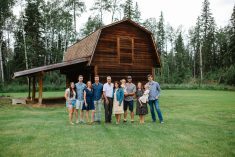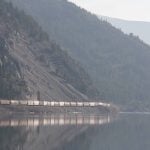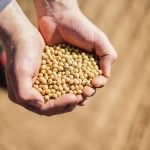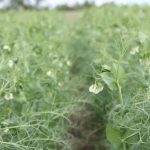he first thing you do is give your head a shake. What could those lions possibly be doing here? Even if, like me, you don’t know anything about their background — for instance that they’re lions of Buddha, also known as guardian lions, and that they started appearing at the entrances to homes, businesses and public buildings in the Han Dynasty 2,000 years ago — it’s obvious that these sculptures are Chinese.
And if, out here in rural Saskatchewan, they’re Chinese, that means they don’t quite belong.
Read Also

Country Guide November editorial: The now, the next and the numbers
I must admit that when I was younger numbers mystified and frustrated me. In fact, my typically jovial grade six…
Or do they?
One thing is certain, and that’s that they’re here, guarding this laneway just off a grid road in the north eastern part of the province, and that they’re perched in front of an operation that looks for all the world like any other ag company, with no-nonsense steel pole buildings and row upon row of grain bins.
So we go inside to ask our question, and we find our answer in the manager’s office of Ag-Vision Seeds, of Carrot River, Sask., population 1,000. He is Cao Chun Hua, better known in the area as Hua (pronounced Wah).
Over the past dozen years, Hua has built a business on what was essentially an abandoned rail spur, a scrap of land where area farmers loaded producer cars in an empty field.
It’s a piece of ground that the area’s farmers have known for generations, but the story of the man who is driving this business is a long and winding one that begins in northern China, at the end of the dark period known as the Cultural Revolution.
Any opportunity
The year was 1979, and Hua was a young man of 20, preparing for university entrance exams. But these were exams with a difference.
For 10 years the cultural revolution had all but halted the country’s education system. Political purges sent many academics into the countryside for “reeducation.” Anyone with above-average skills was in danger of being declared a class enemy.
“These were the first exams (since the start of the Cultural Revolution) that would grant university entrance on merit,” Hua explains.
These tests represented an opportunity for the youth of China to earn a better life through their own hard work. But the backlog also meant fierce competition. After writing his exams, Hua learned he was eligible for placement at an agriculture college studying grassland management. There was only one catch — Hua admits he’d never really had any exposure to agriculture of any sort.
“I grew up in a small city in Jilin Province — about three million people,” Hua explains. “My father was a fireman — a fire-policeman is what they
“ in the forage seed business, this isn’t the middle of nowhere. it’s right in the middle of things.”
— Cao Chun Hua
call them in China — and my mother worked in a factory that made glass bottles for medicines like insulin.”
It was hardly a promising beginning for the career of the self-made agriculture entrepreneur who felt he had it in him to eventually take a new continent by storm, but Hua wasn’t going to let that stop him. After he got a bit more information on the course in question, he decided it was his best path forward. Over the next few years he studied hard, earned an undergraduate degree, then a masters degree, including field work in far-flung and isolated places like Mongolia.
After earning his graduate degree in the late 1980s, Hua qualified for a short-term exchange program that brought him to Canada, where he worked at another local seed house in Nipawin, about 25 miles from Carrot River. He enjoyed the work and says he didn’t have much trouble adjusting to the new reality of life along the treeline of Western Canada.
“Sometimes when Chinese come to places like this, that are a bit isolated, it can be very hard for them, but I was used to it because I’d worked in Mongolia and that prepared me for it a bit,” Hua says.
Settling in at the seed house, he first began working in the operation’s lab. Because immigration red tape had snarled up his entry to Canada, he was able to arrange a longer stay, and later was granted another extension by the Chinese government because he proved he was learning valuable new skills. His wife and oldest daughter remained in China and he always intended to return — until the spring of 1989.
That was when he, and the rest of the world, learned that Beijing’s new-found tolerance for economic freedom did not extend to political freedom. Emboldened by the collapse of communism throughout Europe, China’s students and intellectuals began protesting in Tiananmen Square, calling for the arrival of democracy in the Middle Kingdom.
The regime tolerated it for a few weeks, then on June 4, the tanks rolled in to clear the square. By the time order had been restored, according to an estimate by the International Red Cross, 3,000 people were dead.
Back in Nipawin, Hua walked into his boss’s office and made a simple request.
“I said, ‘I want to stay here, and I want to bring my family over, and I need your help,’” Hua says. “They said, ‘Of course.’”
For the next several years the story is a quiet one. Hua’s young family joined him in Nipawin and he continued working at the established seed house, eventually moving into sales where he made valuable contacts throughout the industry. And the story might have ended there, except for changes at the company.
A large Swedish-based multinational took ownership of the operation in the mid-1990s and it wasn’t long before the existing management team was gone, along with the personal touch of a small, locally owned company.
With his reputation and skills, Hua fielded a few offers from other companies, but decided he wanted to establish his own operation, which he did in 1998 with a local partner, whom he later bought out.
The gambler
Starting a business is one thing. But how do you build something from nothing, and as quickly as this?
First, says Hua, you have to know the supply end. In fact, you have to know it better and before anyone else.
In a nutshell, this is why Hua’s operation is located in rural Saskatchewan in the heart of production country, rather than at port where he could simply take delivery of the seed.
“I’ve had people ask me, ‘Hua, why did you build this plant here, in the middle of nowhere?’” he explains. “But in the forage seed business, this isn’t the middle of nowhere. It’s right in the middle of things.”
Hua explains that the farmers in the region have generations of experience growing forage seeds in the challenging climate of the northern grain belt. They know what they’re doing, and by being on the spot and engaging with them and by tracking crop progress, Hua has the inside track on the production issues that may move markets.
“If there’s been a frost the night before, I can get out and have a look at the fields right away,” Hua explains.
Then on the other end of the equation there’s knowing what the demand side is likely to do, and anticipating and capitalizing on any market movers.
“The first year I was watching the dry weather in the western U. S. and I knew there was going to be some big (forest) fires,” Hua says. “Back then that meant they’d buy a lot of crested wheat grass, which they would sow to hold the ground down.”
In anticipation of this, Hua began buying crested wheat grass seed. And kept buying it, despite the fact that the fires had not yet materialized. It was
a gamble, Hua admits, but one that eventually paid off when 300,000 acres went up in flames. “It’s part of the Chinese character,” Hua says with a laugh. “Taking that gamble — but I try to only gamble what I can afford to lose.”
That said, he’s also disarmingly candid about the luck that the organization enjoyed in the early years.
“It was one gamble after another, and they all paid off,” Hua says.
Another strategic plank in the operation’s success is trying to work with the farmers who grow the seed. Sometimes, Hua explains, both he and the farmer can be winners. He cites a deal for intermediate wheat grass he made in the first couple years. He knew the crop was going to be in short supply and he knew a farmer in Alberta who he’d dealt with in the past had a good supply of it.
“I went out to see him and asked him what he’d take for it,” Hua says. “He told me, ‘The market is so many cents a pound right now.’ I told him, ‘I’ll sign a contract for that right now, and I’ll also pay more if the market rises.’ He looked at me and said, ‘You’ve got a problem, Hua, but I’ll take that deal.’ We’re still friends today.”
In terms of textbook business theory, it might have seemed counterintuitive to offer to share profits, but Hua says locking up the supply early in the season proved more important than extracting every last dollar from the deal.
In the end, however, the expected market in the U. S. didn’t materialize for the full amount. Hua was forced to scramble, but these are the times that separate the success stories from the also-rans. In short, Hua did find a market… a new one, back home in China.
That country has been struggling with a desertification issue that they’ve been combating in recent years with a combination of forestry and grassland protection and improvement. Hua sent a few samples out that fall to his contacts from his student days and urged them to plant the seed.
“They saw it come up that spring and said, ‘This stuff looks pretty good,’” Hua says. Soon the company was shipping container loads over to China, garnering major sales.
“That was actually when a lot of people took notice of the company,” Hua says. “We were the largest exporter of forage seed to China that year and people saw that and said, ‘Ag-Vision? From Carrot River? It can’t be those guys. Is there another Ag-Vision Seeds?’”
Settled in
It’s a long way from where he started, but Hua definitely seems to have found a new home in Carrot River.
In his office there are Chinese characters on banners spelling out important ideals and a photograph of him on a northern lake proudly displaying a decent-size northern pike.
Today his business chalks up annual sales of more than $10 million, employs 15 people, including some former colleagues from his days in Nipawin, and has bright prospects. He’s also secured his family’s future and his daughter who joined him here after Tiananmen Square recently graduated from a U. S. Ivy League university.
“I think she’s proud of us, and what we’ve done,” Hua says. “It gave her a lot of opportunities she’d have never had otherwise.”
If there is a regret, it’s that his former country wasn’t a place where he could find the same opportunities — though he wonders if that would be the case today.
“There have been so many changes in the past 10 years — you wonder,” Hua says. CG
a gamble, Hua admits, but one that eventually paid off when 300,000 acres went up in flames. “It’s part of the Chinese character,” Hua says with a laugh. “Taking that gamble — but I try to only gamble what I can afford to lose.”
That said, he’s also disarmingly candid about the luck that the organization enjoyed in the early years.
“It was one gamble after another, and they all paid off,” Hua says.
Another strategic plank in the operation’s success is trying to work with the farmers who grow the seed. Sometimes, Hua explains, both he and the farmer can be winners. He cites a deal for intermediate wheat grass he made in the first couple years. He knew the crop was going to be in short supply and he knew a farmer in Alberta who he’d dealt with in the past had a good supply of it.
“I went out to see him and asked him what he’d take for it,” Hua says. “He told me, ‘The market is so many cents a pound right now.’ I told him, ‘I’ll sign a contract for that right now, and I’ll also pay more if the market rises.’ He looked at me and said, ‘You’ve got a problem, Hua, but I’ll take that deal.’ We’re still friends today.”
In terms of textbook business theory, it might have seemed counterintuitive to offer to share profits, but Hua says locking up the supply early in the season proved more important than extracting every last dollar from the deal.
In the end, however, the expected market in the U. S. didn’t materialize for the full amount. Hua was forced to scramble, but these are the times that separate the success stories from the also-rans. In short, Hua did find a market… a new one, back home in China.
That country has been struggling with a desertification issue that they’ve been combating in recent years with a combination of forestry and grassland protection and improvement. Hua sent a few samples out that fall to his contacts from his student days and urged them to plant the seed.
“They saw it come up that spring and said, ‘This stuff looks pretty good,’” Hua says. Soon the company was shipping container loads over to China, garnering major sales.
“That was actually when a lot of people took notice of the company,” Hua says. “We were the largest exporter of forage seed to China that year and people saw that and said, ‘Ag-Vision? From Carrot River? It can’t be those guys. Is there another Ag-Vision Seeds?’”
Settled in
It’s a long way from where he started, but Hua definitely seems to have found a new home in Carrot River.
In his office there are Chinese characters on banners spelling out important ideals and a photograph of him on a northern lake proudly displaying a decent-size northern pike.
Today his business chalks up annual sales of more than $10 million, employs 15 people, including some former colleagues from his days in Nipawin, and has bright prospects. He’s also secured his family’s future and his daughter who joined him here after Tiananmen Square recently graduated from a U. S. Ivy League university.
“I think she’s proud of us, and what we’ve done,” Hua says. “It gave her a lot of opportunities she’d have never had otherwise.”
If there is a regret, it’s that his former country wasn’t a place where he could find the same opportunities — though he wonders if that would be the case today.
“There have been so many changes in the past 10 years — you wonder,” Hua says. CG















